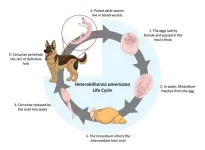(Press-News.org) DURHAM, NC – Living in a poorer neighborhood is linked to accelerated brain aging and increased dementia risk early in life, regardless of income level or education, a Duke University-led study finds.
The study, which appears March 14 in Alzheimer's & Dementia: The Journal of the Alzheimer's Association, suggests that targeting disadvantaged neighborhoods for dementia prevention programs and encouraging clinicians to consider a patient’s address could help lower dementia risk.
“If you want to prevent dementia, and you’re not asking someone about their neighborhood, you're missing information that's important to know,” said clinical neuropsychologist Aaron Reuben, Ph.D., who led the study as a postdoctoral scholar in the joint lab of Duke University psychology and neuroscience professors Avshalom Caspi, Ph.D., and Terrie Moffitt, Ph.D.
Dementia “blue zones”
Alzheimer's disease is the most common form of dementia, a neurological disorder that robs people of their memories and cognitive skills. An estimated 58 million people around the world today have dementia, which is on course to triple to 150 million by 2050.
Despite the expected rise of cases and the immense emotional and financial toll dementia takes on individuals and families, there are no cures or effective medicines.
Researchers are now looking instead to prevent rather than treat dementia through lifestyle changes, like diet and exercise.
Though opting for more vegetables or bike rides may help strengthen brain health and resilience, Reuben was curious if where people live predicts their future dementia risk better than any combination of individual choices.
“I wanted to understand if there was a geographic patterning to dementia the way there is to longevity, like blue zones,” Reuben said, referring to regions where residents appear to live longer than average. “A lot of individual choices, like what you eat, what you do for fun, or who you spend time with, are constrained by where you live.”
Poor neighborhoods beget dementia risk
Reuben and his colleagues at Duke, as well as collaborators at the University of Michigan, Michigan State University, the University of Otago (NZ), and the University of Auckland, looked at the medical records and addresses of 1.41 million New Zealanders to search for patterns.
The team looked at how well-off or disadvantaged each New Zealander’s address was on a scale from one to ten, using information from the national census on average income, employment, and education levels, as well as transportation accessibility and other related factors.
Similar to smaller-scale studies of people in the United States and England, Reuben and his team found that those residing in the most disadvantaged areas had a 43% increased risk of developing dementia over 20 years of observation.
Reuben said the finding still begged the question whether biological signs for neighborhood-associated neurodegeneration could be seen earlier in adulthood, long before people would show up in clinics with memory complaints.
Accelerated brain aging
Reuben and his team then analyzed data from the Dunedin Study, which has tracked nearly 1,000 New Zealanders since birth, documenting their psychological, social, and physiological health, including brain scans, memory tests, and cognitive self-assessments in adulthood.
Reuben found that study members living in disadvantaged neighborhoods across adulthood had measurably poorer brain health as early as age 45, regardless of their own personal income or education.
“It’s not just what personal resources you have, it’s also where you live that matters,” said Caspi.
Poorer brain health was seen across a number of measurements, such as fewer or smaller nerve cells in the brain’s information processing areas and less efficient communication between cells across the brain, as well as more atrophy and, potentially, microbleeds.
Study members living in poorer neighborhoods also had visibly older brains at 45 when the researchers looked at MRI scans, with individuals from the most disadvantaged neighborhoods having brains that appeared three years older than expected given their chronological age. They also scored worse on memory tests and reported more problems with everyday cognitive demands, like following conversations or remembering how to navigate to familiar places.
Addressing location for dementia prevention
These results indicate that living in a disadvantaged neighborhood is a risk factor for dementia, Reuben says. How poorer neighborhoods might increase someone’s risk is still unclear, but it could be the result of a number of things associated with deprived areas, such as worse air quality, lower levels of daily social interactions, higher levels of stress, and less walkability.
Combating increased dementia risk stemming from disadvantaged neighborhoods, however, may be simple and low-cost. Community-focused interventions, such as targeting dementia prevention programs to underserved neighborhoods, or developing vacant lots into pocket parks, might help direct resources where they are most needed.
For now, though, Reuben argues that just factoring in someone’s neighborhood early-on is critical to catch and curb accelerated brain aging and dementia risk.
“If you want to truly prevent dementia, you've got to start early, because 20 years before anyone will get a diagnosis, we're seeing dementia’s emergence,” Reuben said. “And it could be even earlier.”
Funding for the study was provided by the National Institutes for Health (R01AG032282, R01AG069939, R01AG049789, P30 AG028716, P30 AG034424, F32ES34238, P30AG066582), UK Medical Research Council (MR/X021149/1), New Zealand Health Research Council (15-265; 16-604), Brain Research New Zealand, New Zealand Ministry of Business, Innovation, and Employment, and the Duke/University of North Carolina Alzheimer’s Disease Research Center Research.
CITATION: “Dementia, Dementia’s Risk Factors and Premorbid Brain Structure are Concentrated in Disadvantaged Areas: National Register and Birth-Cohort Geographic Analyses,” Aaron Reuben, Leah Richmond-Rakerd, Barry Milne, Devesh Shah, Amber Pearson, Sean Hogan, David Ireland, Ross Keenan, Annchen R. Knodt, Tracy Melzer, Richie Poulton, Sandhya Ramrakha, Ethan Whitman, Ahmad R. Hariri, Terrie E. Moffitt, Avshalom Caspi. Alzheimer's & Dementia: The Journal of the Alzheimer's Association, March 14, 2024. DOI: 10.1002/alz.13727
END
Poor neighborhoods linked to elevated dementia risk and faster brain aging
Irrespective of income or education, people living in disadvantaged neighborhoods show early signs of cognitive decline
2024-03-14
ELSE PRESS RELEASES FROM THIS DATE:
Dog-killing flatworm discovered in Southern California
2024-03-14
UC Riverside scientists confirm, for the first time, that a potentially fatal dog parasite is present in a portion of the Colorado River that runs through California.
The parasite, Heterobilharzia americana, is a flatworm commonly referred to as liver fluke. Previously found almost exclusively in Texas and other Gulf Coast states, it has never been reported this far west. The worm can cause canine schistosomiasis, an illness that impacts the liver and intestines of dogs.
“Dogs can die from this infection, so we are hoping ...
It’s hearty, it’s meaty, it’s mold
2024-03-14
With animal-free dairy products and convincing vegetarian meat substitutes already on the market, it’s easy to see how biotechnology can change the food industry. Advances in genetic engineering are allowing us to harness microorganisms to produce cruelty-free products that are healthy for consumers and healthier for the environment.
One of the most promising sources of innovative foods is fungi – a diverse kingdom of organisms that naturally produce a huge range of tasty and nutritious ...
First gene therapy tests in whole human liver
2024-03-14
In a worldwide first-of-its-kind study published in the prestigious journal Nature Communications this week, a team of scientists from Children’s Medical Research Institute (CMRI) tested novel gene therapies in a whole human liver, with the goal of developing more effective treatments for life-threatening inherited diseases.
Gene therapy is a revolutionary approach to treating serious genetic diseases that most commonly involves replacing or repairing a faulty gene. The most efficient delivery systems today are those based on a harmless virus named adeno-associated ...
Researchers target cancer’s ability to survive at low oxygen levels
2024-03-14
Researchers at the Francis Crick Institute have shed light on how cancer cells survive in the first few hours after being cut off from a supply of oxygen.
Published today in The EMBO Journal, this finding could one day help to prevent cancer from becoming resistant to therapy.
A major use of oxygen by cells is for energy production. When oxygen supplies are low, most cells can survive because they adapt, by changing which proteins they make, to produce energy through different processes than in normal oxygen levels. This is coordinated by a protein called HIF1α, which turns on the activity of genes.
Although HIF1α ...
African American veterans with PTSD had higher risk of re-hospitalization after stroke
2024-03-14
Research Highlights:
In a review of data for more than 90,000 veterans hospitalized with stroke, African American veterans who had been previously diagnosed with post-traumatic stress disorder (PTSD) were significantly more likely to be re-hospitalized than African American veterans without PTSD.
In contrast, white veterans with PTSD were not significantly more likely to be re-hospitalized after stroke than white veterans without PTSD.
Illicit drug use and Type 2 diabetes also raised the hospital readmission risk in African American veterans ...
Researchers can reveal illegal timber exports
2024-03-14
A new method of timber analysis developed by researchers from the University of Gothenburg can confidently identify the location in which the tree was harvested. The method has been developed with the aim of combating illegal timber imports from Russia and Belarus.
Illegal logging and the associated trade in wood products is a global problem that threatens some of the world's most important ecosystems. Researchers are trying to combat this practise with a new scientific method that can reveal ...
Study shows potential for using AI tools to detect healthcare-associated infections
2024-03-14
Arlington, Va. — March 14, 2024 — A new proof-of-concept study published today in the American Journal of Infection Control (AJIC) reports that artificial intelligence (AI) technologies can accurately identify cases of healthcare-associated infections (HAI) even in complex clinical scenarios. The study, which highlights the need for clear and consistent language when using AI tools for this purpose, illustrates the potential for incorporating AI technology as a cost-effective component of routine infection surveillance programs.
According to the most recent HAI Hospital ...
ESHRE launches factsheets to highlight environmental threats to fertility and reproductive health
2024-03-14
Governments must act now to address the effects of climate change and air pollution on fertility rates and reproductive health, says a document published by the European Society of Human Reproduction and Embryology (ESHRE) today (Thursday).
The factsheets* provide comprehensive information on global warming, evidence of its impact on fertility, and calls on policymakers to promote swift prevention measures.
Priorities should be to reach net zero CO2 emissions within the next 20 years, and to keep global warming within a 1.5% increase, says the expert ...
Olympic tower construction at Teahupo’o, Tahiti could damage reef ecosystem
2024-03-14
In preparation for the 2024 Olympic surfing competition, a new judging tower is being constructed in the reef lagoon at Teahupo’o, Tahiti. Researchers from the University of Hawai‘i (UH) at Mānoa, UH Hilo, and Arizona State University and community partners in Tahiti recently published a study in Remote Sensing that assessed the potential impacts of the tower and emphasized the importance of protecting the valuable reef—both as an integral part of the ecosystem and a resource for the local community.
“We ...
UNH ingenuity offers unique way to track carbon emissions in bodies of water
2024-03-14
DURHAM, N.H. — Carbon dioxide (CO2) emissions are not typically associated with water ways, like streams and rivers, but emerging research shows that water bodies play an important role in storing and releasing carbon dioxide. As many states look for cost-effective ways to mitigate climate change, scientists at the New Hampshire Agricultural Experiment Station at the University of New Hampshire looked at a way to optimize CO2 sensors to better measure carbon dioxide emissions in lotic, or moving, bodies of water offering a new tool that can help provide valuable information for everything from land use to climate action plans.
“These sensors, adapted for highly ...
LAST 30 PRESS RELEASES:
Tracing the quick synthesis of an industrially important catalyst
New software sheds light on cancer’s hidden genetic networks
UT Health San Antonio awarded $3 million in CPRIT grants to bolster cancer research and prevention efforts in South Texas
Third symposium spotlights global challenge of new contaminants in China’s fight against pollution
From straw to soil harmony: International team reveals how biochar supercharges carbon-smart farming
Myeloma: How AI is redrawing the map of cancer care
Manhattan E. Charurat, Ph.D., MHS invested as the Homer and Martha Gudelsky Distinguished Professor in Medicine at the University of Maryland School of Medicine
Insilico Medicine’s Pharma.AI Q4 Winter Launch Recap: Revolutionizing drug discovery with cutting-edge AI innovations, accelerating the path to pharmaceutical superintelligence
Nanoplastics have diet-dependent impacts on digestive system health
Brain neuron death occurs throughout life and increases with age, a natural human protein drug may halt neuron death in Alzheimer’s disease
SPIE and CLP announce the recipients of the 2025 Advanced Photonics Young Innovator Award
Lessons from the Caldor Fire’s Christmas Valley ‘Miracle’
Ant societies rose by trading individual protection for collective power
Research reveals how ancient viral DNA shapes early embryonic development
A molecular gatekeeper that controls protein synthesis
New ‘cloaking device’ concept to shield sensitive tech from magnetic fields
Researchers show impact of mountain building and climate change on alpine biodiversity
Study models the transition from Neanderthals to modern humans in Europe
University of Phoenix College of Doctoral Studies releases white paper on AI-driven skilling to reduce burnout and restore worker autonomy
AIs fail at the game of visual “telephone”
The levers for a sustainable food system
Potential changes in US homelessness by ending federal support for housing first programs
Vulnerability of large language models to prompt injection when providing medical advice
Researchers develop new system for high-energy-density, long-life, multi-electron transfer bromine-based flow batteries
Ending federal support for housing first programs could increase U.S. homelessness by 5% in one year, new JAMA study finds
New research uncovers molecular ‘safety switch’ shielding cancers from immune attack
Bacteria resisting viral infection can still sink carbon to ocean floor
Younger biological age may increase depression risk in older women during COVID-19
Bharat Innovates 2026 National Basecamp Showcases India’s Most Promising Deep-Tech Ventures
Here’s what determines whether your income level rises or falls
[Press-News.org] Poor neighborhoods linked to elevated dementia risk and faster brain agingIrrespective of income or education, people living in disadvantaged neighborhoods show early signs of cognitive decline




